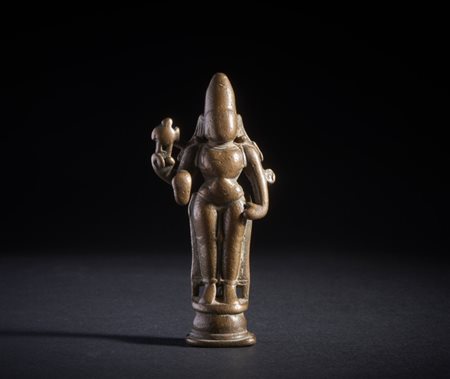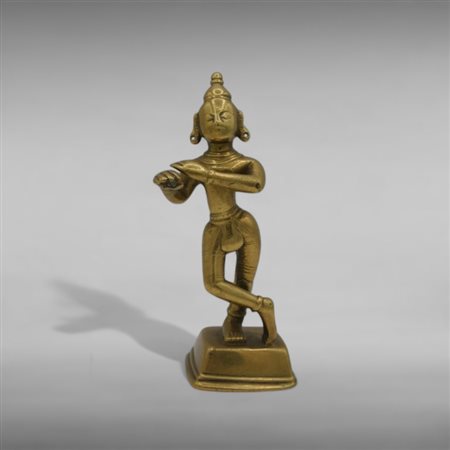Pre-Asta Islamic and Indian art from a Private Collection in Rome and other provenances. In partnership with BAIAS Arte.
-

Lotto 169 A copper alloy figure of Lord Vishnu
Northern India, 17th century
Small cast depicting the deity standing on a small circular base. The figure has four arms (one of which is now missing): the two main ones displaying mudras, the hand of the remaining secondary one wields the shell.
H. 8.5 cm -

Lotto 170 A bronze figure of Balakrishna
Southern India, 17th-18th century
Copper alloy casting depicting the child deity on all fours on a rectangular plinth. His right hand holds the butter ball, while his left hand is resting on the jar from which he has taken it. Beautiful details of the belt, headdress and jewellery.
4 X 5 X H. 7 cm -

Lotto 171 A copper alloy figure Annapurna
Southern India, 17th - 18th century
Copper alloy casting depicting one of the manifestations of Parvati, seated in half lotus position on a tiered base. With her main attribute, the spoon, she dispenses food to the needy.
H. 8 cm -

Lotto 172 A bronze figure of Tripurasundari
India, 19th century
Bronze casting depicting the deity associated with the Sri Yantra, on which he sits with her legs crossed in padmasana. Her left hand bears the sugarcane bow as an attribute.
5.2 X 5.2 X H. 10 cm -

Lotto 173 Krishna Venugopala North-Eastern
India, Orissa, 19th century
Brass casting, depicting the deity standing, legs crossed and arms in the act of playing the flute, now missing.
H. 13.8 X 4.9 X 4.7 cm -

Lotto 174 Jain altar depicting Parshva assisted by four Thirtankaras.
India, Gujarat, dated 1477 CE
This type of icon is known as pancha-tirthika, a term referring to a composition comprising five Jinas: a seated central figure surrounded by four smaller Thirtankaras. The central figure is Parshva, the twenty-third Jina, as indicated by the seven-headed serpent hood above his head. The standing figures in the composition wear robes around their hips, thus identifying the altarpiece with the Svetambara tradition.
The thirtankara has silver inlaid eyes. Long insciption engraved at the back of the prabha.
20.8 x 12.2 x 7.9 cm -

Lotto 175 Small devotional bronze depicting Durga
Central India, 18th century
bronze casting with dark patina, depicting Durga Mahishasuramardini in the act of slaying the buffalo demon.
H. 5.5 X L. 3 cm -

Lotto 176 A copper alloy figure of Krishna Venugopala
Fine devotional bronze depicting the deity standing on a square plinth, legs crossed and arms in the position of playing the flute.
H. 13.5 cm -

Lotto 177 Two metal spice or kohl holders
India, 19th century
Bronze casting in the classic form with a central pivot shaped as a peacock surrounded by five containers with mango-shaped covers surmounted by peacocks.
H. 8.5 X 9 cm (the largest) -

Lotto 178 Bronze depicting BalaKrishna
Central India, 19th century
Bronze casting depicting Krishna sitting on a snake coil. This representation is related to an episode from Krishna's childhood when he defeated the serpent Kaliya and then sucked his own toe, showing his divine and playful nature. The back is missing the head of the snake, which probably served as a canopy.
H. 9.3 X 8 cm -

Lotto 179 Bronze figure of Karttikeya on the peacock
India, late 19th century
H 11.3 X L. 10.5 cm -

Lotto 180 A highly decorative large wooden horse coated with embossed and engraved copper sheet
Northern India, Rajasthan, 19th century
A massive wooden horse coated with an embossed metal sheet engraved in a lifelike style to evoke the mane and the harnesses decorated with minute floral motifs and small multiple bells.
H. 140 X l. 117 X P. 25 cm -

Lotto 181 Sandstone sculpture depicting a minor deity
India, 12th-13th century
Part of a secondary decoration of a palace, depicting a crowned character holding a vase to his chest with folded hands. The figure is surrounded by a corolla of lotus petals forming the round base.
31 X 31 cm
